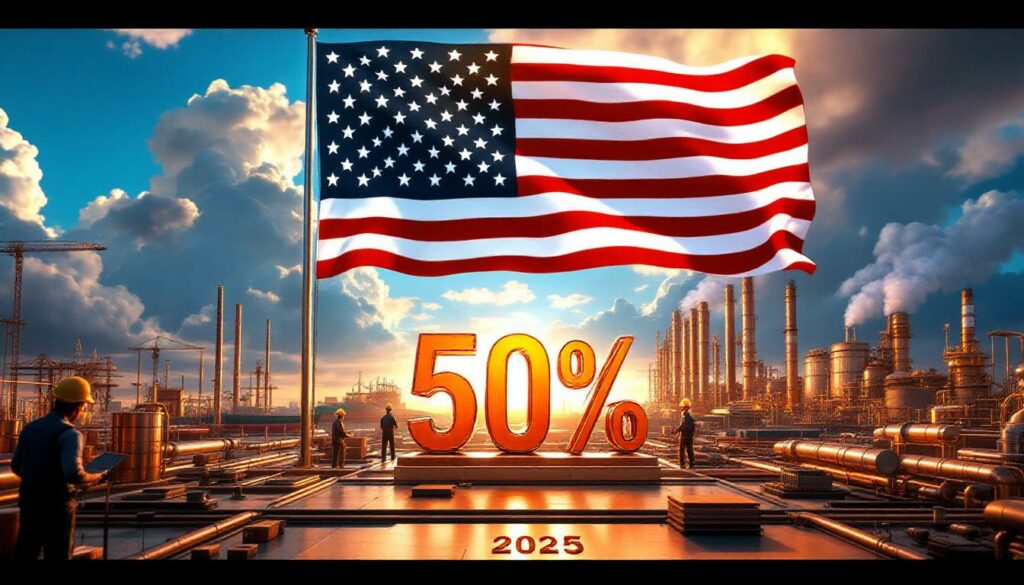US Copper Tariffs: Understanding the 50% Import Tax and Its Implications
The United States' decision to implement a substantial 50% tariff on copper imports represents one of the most significant trade policy shifts in recent years for the metals sector. This comprehensive measure targets a wide range of copper products while establishing new domestic requirements that will reshape supply chains both within America and globally.
What Are the New US Copper Tariffs?
Key Details of the 50% Copper Tariff
The United States has implemented a significant 50% tariff on various copper imports, set to take effect August 1, 2025. This substantial trade barrier specifically targets semi-finished copper products including pipes, wires, rods, sheets, and tubes, along with copper-intensive derivative products such as pipe fittings, cables, connectors, and electrical components.
The policy, officially known as "copper 232 tariffs," employs a distinctive approach by targeting only the copper content within these products. This means that for products containing both copper and other materials, the 50% tariff applies exclusively to the copper portion, while non-copper content remains subject to other applicable duties or reciprocal tariffs.
According to industry analysts, this methodology represents a more sophisticated approach than blanket tariffs, allowing for proportional taxation based on actual copper content rather than the total product value.
Exemptions and Scope Limitations
Several important exemptions exist within the copper tariff framework. Raw copper input materials—including ores, concentrates, and cathodes—are explicitly excluded from these new tariffs. Additionally, copper scrap materials have been granted exemption status, recognizing their critical role in circular supply chains and domestic recycling operations.
The policy also addresses potential tariff overlaps, particularly with automotive products. In cases where automotive Section 232 tariffs already apply to certain products, those will take precedence over the copper tariffs rather than being applied cumulatively, preventing double taxation on affected goods.
Industry Insight: "The exemption for raw materials strategically encourages domestic processing while still allowing cost-effective imports of primary inputs—essentially pushing for value addition to happen on American soil," notes a senior metals analyst from Mining Technology.
Why Has the US Implemented These Tariffs?
National Security Concerns
The implementation follows a comprehensive Section 232 investigation conducted by the Secretary of Commerce, which identified copper as a critical component for national and economic security. The investigation highlighted specific vulnerabilities in the domestic copper industry that could potentially compromise America's industrial readiness in times of international tension.
Section 232 investigations, authorized under the Trade Expansion Act of 1962, allow the Commerce Department to determine if certain imports threaten to impair national security. This security-focused approach mirrors similar actions taken with steel and aluminum in recent years, establishing a pattern of treating industrial metals as strategic assets.
Copper's critical applications in defense, telecommunications, and energy infrastructure underpinned the security justification. The metal is essential for military applications, electrical grids, and emerging technologies—sectors where import dependence creates strategic vulnerabilities.
Trade Deficit Reduction Strategy
According to White House documentation, the US copper industry faces significant challenges from foreign competition and environmental regulations, resulting in what officials describe as a "massive" trade deficit in copper products. While specific deficit figures weren't disclosed in the announcement, industry data indicates the US has been a net importer of refined copper for decades.
The tariffs represent a direct attempt to address this imbalance by making imported products substantially more expensive, thereby encouraging domestic sourcing and reducing American dependence on foreign copper product imports.
Domestic Industry Revitalization
The tariffs form part of a broader "America First" trade strategy aimed at revitalizing domestic industries that have faced decline in recent decades. By creating more favorable conditions for US copper producers through protective tariffs, the administration hopes to stimulate investment in domestic production capacity.
Industry projections suggest the tariffs could potentially create thousands of manufacturing jobs within the copper sector and adjacent industries, particularly in traditional mining regions that have experienced economic challenges. This includes areas like Arizona, Utah, Montana, and Michigan, where copper mining has historically been a significant employer.
How Will the Tariffs Impact the Domestic Copper Supply Chain?
Domestic Scrap Retention Requirements
Beyond the tariffs themselves, the proclamation includes additional measures to strengthen the domestic copper industry. Most notably, it mandates that 25% of high-quality copper scrap produced in the United States must be sold domestically rather than exported.
This provision aims to enhance access to critical feedstock materials for local fabricators and refiners, addressing a long-standing industry concern about valuable scrap being exported while domestic processors struggle to secure adequate materials.
Copper scrap plays a crucial role in the industry as a lower-energy, lower-cost input compared to primary production. By ensuring a guaranteed minimum domestic supply, manufacturers can potentially stabilize input costs despite tariff-related price increases on imported materials.
Export Licensing System
To ensure compliance with domestic supply requirements, the Secretary of Commerce has been directed to implement an export licensing requirement specifically for high-quality copper scrap. This system will monitor outflows of valuable scrap material and help maintain sufficient domestic supply levels.
The licensing regime represents a significant shift in US scrap metal policy, which has historically focused on free trade. Industry experts note that this system will require development of new classification standards to determine which grades of scrap fall under the "high-quality" designation requiring licenses.
Future Domestic Production Mandates
Starting in 2027, the policy will require that 25% of copper input materials produced in the US be sold within the country. This percentage is scheduled to increase in subsequent years, creating a guaranteed domestic market for US producers.
This measure specifically targets the expansion of US refining capacity by securing low-cost inputs for domestic refiners as they grow their operations. By establishing predictable demand, the policy aims to encourage capital investment in an industry that requires substantial upfront costs to expand or modernize facilities.
Expert Analysis: "The graduated approach—starting with scrap retention immediately and progressing to input material requirements by 2027—gives the industry time to adapt while sending clear market signals for long-term investment," according to mining sector economists.
What Are the Broader Economic Implications?
Impact on International Trade Relations
The implementation of these substantial tariffs could potentially strain international trade relationships, particularly with major copper-exporting nations like Chile, Peru, and Canada. The 50% rate represents a significant barrier to foreign suppliers and may invite retaliatory measures from affected countries.
Historical precedent suggests that targeted countries often respond with counter-tariffs on US exports, potentially affecting agricultural products, technology, or other sectors important to the American economy. Additionally, the measure may face challenges through the World Trade Organization's dispute resolution system, though such processes typically take years to resolve.
Price Effects for Downstream Industries
Domestic manufacturers who rely on copper inputs may face higher material costs as a result of these tariffs. Industries such as electronics, construction, renewable energy, and automotive manufacturing all depend heavily on copper components and could experience cost pressures that may ultimately be passed to consumers.
The price effects may be particularly pronounced for:
- Electrical equipment manufacturers: Motors, transformers, and switchgear contain significant copper content
- Renewable energy: Solar installations and wind turbines require substantial copper wiring
- Construction sector: Plumbing, HVAC, and electrical systems utilize copper extensively
- Electric vehicle production: EVs contain 2-4 times more copper than conventional vehicles
Some manufacturers may absorb these costs initially, but sustained price increases will likely reach consumers through higher prices for copper-intensive products.
Potential for Supply Chain Restructuring
The combination of tariffs and domestic supply requirements could trigger significant restructuring within copper supply chains. Foreign suppliers may consider establishing US-based operations to avoid tariffs, while domestic producers may expand capacity to meet growing local demand.
This restructuring could manifest in several ways:
- Foreign copper product manufacturers relocating facilities to the US
- Increased investment in copper recycling infrastructure
- Acceleration of substitution efforts where alternatives to copper exist
- Development of more sophisticated copper supply contracts with price adjustment mechanisms
How Do These Tariffs Fit Into Broader US Trade Policy?
Alignment with Other Protective Measures
The copper tariffs align with other recent trade actions, including increased tariffs on steel and aluminum and the imposition of additional 10% tariffs on imports from China. These measures collectively reflect an emphasis on protecting domestic industries through trade barriers.
This approach represents a continuation of the shift toward more protectionist policies that began in previous administrations. Industry analysts note that the copper trade war impact follows the exact same legal mechanism—Section 232 of the Trade Expansion Act—used to justify steel and aluminum tariffs, suggesting a consistent strategy rather than an isolated action.
Regulatory and Investment Environment
Beyond tariffs, the administration has pursued complementary policies to promote mining, manufacturing, and investment within the United States. These include regulatory reductions designed to ease operational burdens on domestic producers and consideration of additional tariffs against digital service taxes and policies targeting US companies.
The copper industry has specifically benefited from streamlined permitting processes for new mining operations and expansions, with federal agencies directed to prioritize reviews of critical mineral projects. This regulatory approach complements the tariff strategy by addressing both market access and production costs simultaneously.
Strategic Materials Focus
The focus on copper highlights growing concerns about critical material supply chains, particularly for metals essential to infrastructure, defense, and emerging technologies. This approach suggests potential similar actions for other strategically important materials in the future.
Industry observers note that copper's designation as a strategic material signals heightened attention to mineral security broadly. Materials that could see similar treatment include:
- Nickel, essential for battery technologies
- Lithium, critical for energy storage
- Rare earth elements, required for electronics and defense applications
- Cobalt, used in superalloys and batteries
What Could Be the Global Market Response?
Price Volatility in Copper Markets
The implementation of such significant tariffs on a major economy like the United States could create price volatility in global copper markets as supply chains adjust. While raw materials are exempt, the tariffs on processed products could shift manufacturing patterns and trading relationships.
Initially, the announcement may create a price premium for US-based copper products while potentially depressing prices in other markets as exporters seek alternative destinations. Over time, price disparities between US and global markets may emerge, creating arbitrage opportunities despite the tariffs.
Historically, similar protective measures have led to domestic price premiums of 15-25% above global benchmarks, though the specific impact will depend on domestic production capacity and substitution possibilities. Recent copper price predictions suggest significant market disruption.
Potential for Trade Diversion
Countries that previously exported copper products to the US may seek alternative markets for their goods, potentially creating oversupply situations in other regions and affecting global pricing dynamics. Conversely, raw copper material flows might increase to the US as domestic processing becomes more economically attractive.
Trade diversion effects could include:
- Increased copper product exports to Europe, Asia, and emerging markets
- Growth in value-added manufacturing in countries with preferential US market access
- Development of triangular trade routes to circumvent direct tariff impacts
- Expansion of copper scrap processing capacity in non-US markets
Investment in Alternative Production Locations
Foreign manufacturers of copper products may consider establishing production facilities in countries with preferential trade access to the US market to circumvent the tariffs. This could lead to manufacturing shifts across global supply chains.
Mexico and Canada, as USMCA partners, could potentially see increased investment in copper fabrication facilities targeting the US market. Similarly, countries with existing free trade agreements with the United States might become more attractive manufacturing locations for copper-intensive products.
Market Analysis: "The 50% tariff rate is so substantial that it will almost certainly drive manufacturing reorganization, particularly for high-value products where the copper component represents a significant cost factor," according to industry forecasts from Mining Technology.
FAQs About the US Copper Tariffs
When do the new copper tariffs take effect?
The 50% tariff on copper imports takes effect on August 1, 2025, following presidential proclamation. This implementation date provides approximately one year for companies to adjust supply chains and sourcing strategies.
Which copper products are exempt from the tariffs?
Raw copper materials including ores, concentrates, cathodes, and copper scrap are exempt from the new tariffs. The exemptions are designed to ensure continued access to primary input materials while encouraging domestic processing and manufacturing.
How do these tariffs interact with other US tariffs?
In cases where automotive 232 tariffs apply to products, those will take precedence over the copper tariffs rather than being applied cumulatively. This prevents double-taxation on products that might fall under multiple tariff regimes and simplifies compliance for importers.
What domestic requirements accompany the tariffs?
The policy requires that 25% of high-quality copper scrap produced in the US must be sold domestically. Beginning in 2027, 25% of copper input materials produced domestically must be sold within the country, with this percentage increasing in subsequent years according to a predetermined schedule.
What is the stated purpose of these tariffs?
The tariffs aim to strengthen national security by reducing dependence on foreign suppliers, address trade deficits in copper products, and revitalize the domestic copper industry by creating more favorable conditions for US producers. The policy explicitly frames copper as a strategic material essential for both economic and military security.
Long-Term Industry Outlook
The implementation of copper tariffs represents just one element of a broader industrial strategy focusing on domestic manufacturing resilience. Industry experts anticipate several long-term developments as markets adjust to the new reality:
- Accelerated domestic investment: Major copper producers likely to announce capacity expansions
- Innovation pressure: Higher material costs driving efficiency improvements in copper utilization
- Recycling emphasis: Enhanced recovery technologies to maximize domestic scrap utilization
- Substitution research: Development of alternatives for non-critical applications
- Supply chain regionalization: Reduced global integration in favor of continental copper markets
While challenges remain in rebuilding domestic capacity after decades of decline, the combination of tariff protection and domestic content requirements creates powerful incentives for industry transformation. The coming years will reveal whether these policy measures achieve their stated goals of revitalizing American copper production and processing capacity.
With surging copper demand from sectors like renewable energy and electric vehicles, the timing of these tariffs could significantly influence the global copper production outlook. Furthermore, investors are already recalibrating their copper investment strategies in response to these developments, with a particular focus on domestic producers who stand to benefit from the protective measures.
According to Reuters, the announcement has already triggered significant market reactions, with copper futures experiencing notable volatility as traders assess the long-term implications of the US announcing 50% tariff on copper imports.
Want to Stay Ahead of the Next Major Mineral Discovery?
Discovery Alert's proprietary Discovery IQ model delivers instant notifications on significant ASX mineral discoveries, transforming complex data into actionable investment insights before the broader market catches on. Explore why major mineral discoveries can lead to substantial returns by visiting Discovery Alert's dedicated discoveries page and position yourself ahead of the market.




